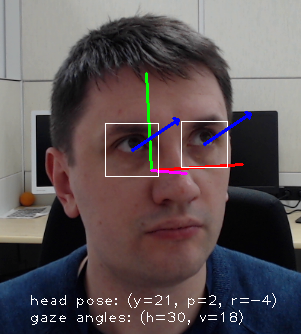gaze-estimation-adas-0002¶
Use Case and High-Level Description¶
This is a custom VGG-like convolutional neural network for gaze direction estimation.
Example and Gaze Vector Definition¶

The network takes three inputs: square crop of left eye image, square crop of right eye image, and three head pose angles - (yaw, pitch, and roll) (see figure). The network outputs 3-D vector corresponding to the direction of a person’s gaze in a Cartesian coordinate system in which z-axis is directed from person’s eyes (mid-point between left and right eyes’ centers) to the camera center, y-axis is vertical, and x-axis is orthogonal to both z,y axes so that (x,y,z) constitute a right-handed coordinate system.
Specification¶
Metric |
Value |
|---|---|
GFlops |
0.139 |
MParams |
1.882 |
Source framework |
PyTorch* |
Validation Dataset¶
Two random held out individuals from an internal dataset containing images of 60 people with different gaze directions.
Validation Results¶
The accuracy of gaze direction prediction is evaluated through the use of MAE of angle (in degrees) between the ground truth and predicted gaze direction.
Dataset |
MAE, degrees |
Standard deviation of AE, degrees |
|---|---|---|
Internal dataset |
6.95 |
3.58 |
Inputs¶
Blob, name:
left_eye_image, shape:1, 3, 60, 60in the formatB, C, H, W, where:B- batch sizeC- number of channelsH- image heightW- image width
Blob, name:
right_eye_image, shape:1, 3, 60, 60in the formatB, C, H, W, where:B- batch sizeC- number of channelsH- image heightW- image width
Blob, name:
head_pose_angles, shape:1, 3in the formatB, C, where:B- batch sizeC- number of channels
Outputs¶
The net output is a blob with name gaze_vector and the shape: 1, 3, containing Cartesian coordinates of gaze direction vector. Please note that the output vector is not normalizes and has non-unit length.
Demo usage¶
The model can be used in the following demos provided by the Open Model Zoo to show its capabilities:
Legal Information¶
[*] Other names and brands may be claimed as the property of others.